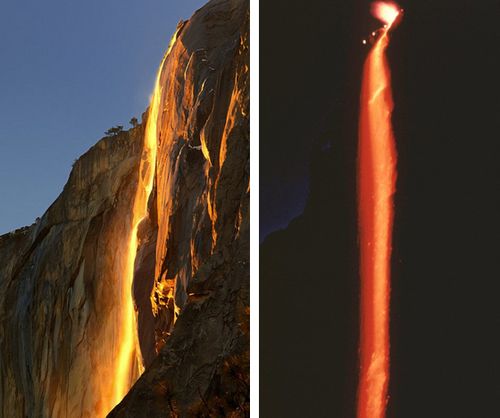
Left: Horsetail Falls, 2011. Photo: Right: The Firefall. Photo: National Park Service
The window is closing on a yearly glimpse of a natural phenomena at Yosemite National Park, during which the angle of the sun and the flow of water off the park's Horsetail Falls commingle in such a way that the waterfall glows, as if aflame. On the ground, photographers come from all over the world to freeze the image on their cameras, as in the photo above, left.
But for nearly 100 years, from 1872 until 1968, a flow of actual fire descended off the the park's Glacier Point, a vista point some 3,000 feet above the valley floor, as in the photo above, right.
The Firefall, as it was called, was set each night during summer. Park officials would collect Red Fir tree bark and set a large bonfire at Glacier Point each day. At 9pm, park workers would take long-handled rakes and push the embers off the cliff, to create the illusion of a waterfall of fire. This was all done to the delight of park visitors, who would convene in Curry Village in the valley to view the spectacle.��
“I saw it as a kid,” Yosemite Park Ranger Scott Gediman says with a chuckle. “The Firefall was a huge tradition and attraction. And it was beautiful.”
When the park decided to end the tradition it wasn't because of fire danger — which was my first guess — or because it set a poor fire safety example. “There's a huge talus slope under Glacier Point,” Gediman reminds me. “The embers might have sparked a tree here or there, but they never caused a major fire.”
When he put an end to the practice in 1968, the National Park Service director��George Hertzog��said the practice was “manufactured entertainment” and therefore not in line with the natural experiences and wonders that should draw visitors to a national park. ��
If the idea of setting a huge bonfire each night and tossing embers thousands of feet to the valley floor sounds insane now, consider another bit of “manufactured entertainment” that used to draw visitors: bear feeding. Garbage pits were filled with the day's refuse and park visitors filed in to watch the valley's bears roam in for some easy pickings.
Predictably, the bears became habituated to the free food and became increasingly aggressive and insistant on hand-outs, which led to an increase in bear attacks and the end of bear feedings in 1940.
Ending the Firefall and reversing the ways we interact with wildlife were part of what Gediman calls a “management shift” in the park, a visit to which had started to look and feel more like Disneyland than a wilderness experience.
Not many years after the Firefall ended, Galen Rowell was driving into the valley one winter's day in 1973 when he saw Horestail Falls glowing. As described in this Yosemite Nature Notes video, he scrambled to set up his gear and capture what is still one of the widely viewed images of the falls. And at about 3:40 into the Nature Notes video, you'll see footage of the Firefall.��
If you want to dig further into the old Firefall and Horsetail Falls, is devoted to the topic.
“I still see people driving around with license plate holders that say 'Bring Back the Firefall',” says Gediman. “But in the past ten or 12 years, the Horsetail Falls have gotten much more popular.”
— Mary Catherine O'Connor
��